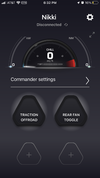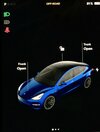With our latest Holiday Update of the S3XY Buttons software, we released a new feature - activating Off-Road.
Tesla made it available exclusively for Model Y for some reason and you cannot activate it in other models but with the S3XY Buttons this is not a limitation anymore.
Everyone can benefit from this mode now!
What is Off-Road mode:
In short - it balances the power of the FRONT and the REAR motors in Dual motor cars in order to prevent slipping and losing control in snow, mud, and ice.
You can see more about the Off-road in Owners Manual here.
How it works:
The power is distributed by the Drive Control Unit which tries to balance the torque of the front and rear motors when accelerating and when decelerating with regen braking.
When accelerating Tesla usually uses rear/front motor in 80/20 and when decelerating it's 100/0 for rear/front in most cases based on a lot of factors.
With Off-road assist enabled the power distribution is almost 50/50 in all cases.
When to use it:
It's useful at low speeds when driving in snow or ice and you need extra grip. If you don't have off-road assist active on Snow and depress the Accelerator pedal the rear of the car will slip and you might lose control.
Note: there are some limitations to other assistant features and the off-road is working only up to 90 km/h so have this in mind when activating the feature. Read more in the Owners Manual here.
Here is a short video of this feature in action. Please, note that the split screen at the end is from one and the same car (Model 3 Performance) with off-road disabled and enabled.
Note how the Torque (rightmost bar) goes equally UP for the Front motor and DOWN for the Rear motor when Off-road is activated.
When the Acceleration pedal is depressed (The blue circle around the speed in the center goes to 0) the Regen kick in and when the off-road is activated the distribution is equal for the Front and Rear motors.
Tesla made it available exclusively for Model Y for some reason and you cannot activate it in other models but with the S3XY Buttons this is not a limitation anymore.
Everyone can benefit from this mode now!
What is Off-Road mode:
In short - it balances the power of the FRONT and the REAR motors in Dual motor cars in order to prevent slipping and losing control in snow, mud, and ice.
You can see more about the Off-road in Owners Manual here.
How it works:
The power is distributed by the Drive Control Unit which tries to balance the torque of the front and rear motors when accelerating and when decelerating with regen braking.
When accelerating Tesla usually uses rear/front motor in 80/20 and when decelerating it's 100/0 for rear/front in most cases based on a lot of factors.
With Off-road assist enabled the power distribution is almost 50/50 in all cases.
When to use it:
It's useful at low speeds when driving in snow or ice and you need extra grip. If you don't have off-road assist active on Snow and depress the Accelerator pedal the rear of the car will slip and you might lose control.
Note: there are some limitations to other assistant features and the off-road is working only up to 90 km/h so have this in mind when activating the feature. Read more in the Owners Manual here.
Here is a short video of this feature in action. Please, note that the split screen at the end is from one and the same car (Model 3 Performance) with off-road disabled and enabled.
Note how the Torque (rightmost bar) goes equally UP for the Front motor and DOWN for the Rear motor when Off-road is activated.
When the Acceleration pedal is depressed (The blue circle around the speed in the center goes to 0) the Regen kick in and when the off-road is activated the distribution is equal for the Front and Rear motors.




